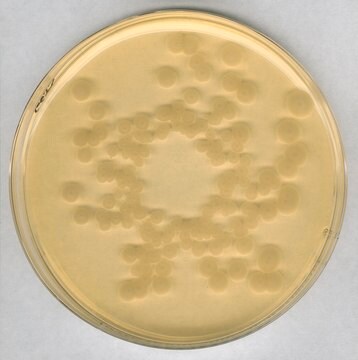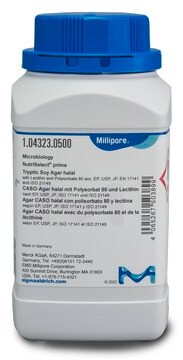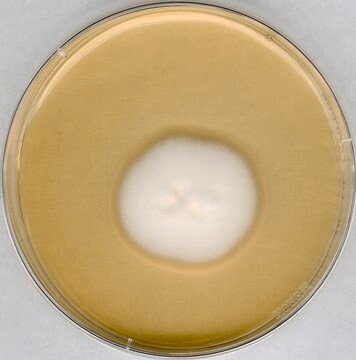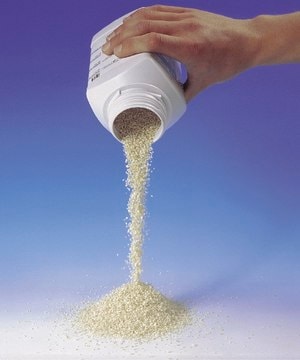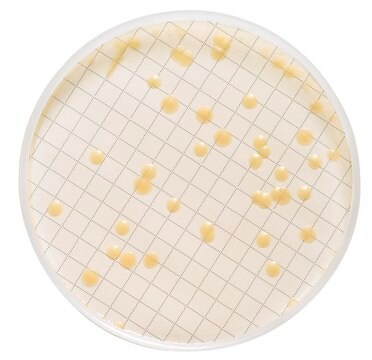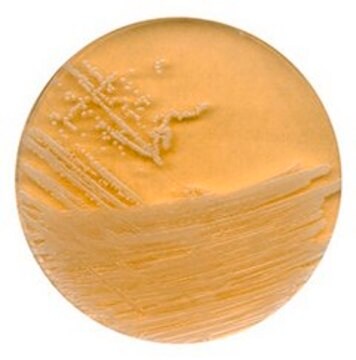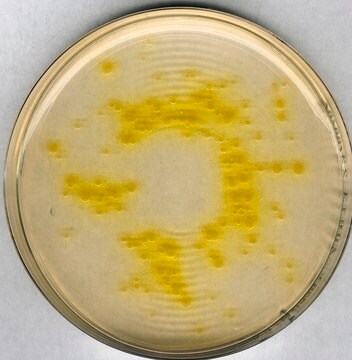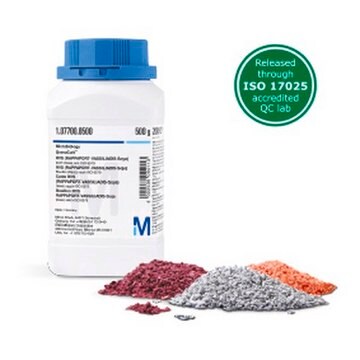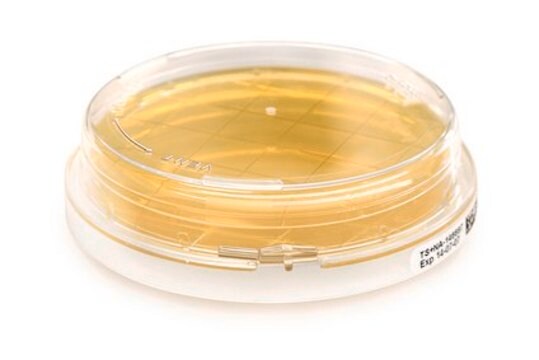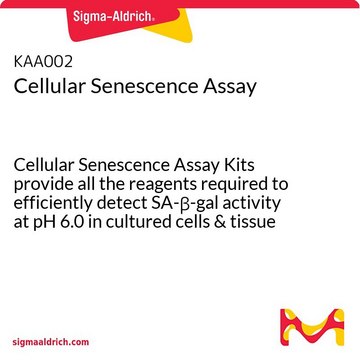1.07324
modified Tryptic Soy Agar- Dehydrated Culture Media
NutriSelect® Prime, with polysorbate 80 and lecithin, according to EP, USP, JP, EN 17141, ISO 21149, powder, suitable for microbiology
Synonim(y):
MCT agar, Microbial Content Test (MCT) Agar, Soybean-casein-digest-lecithin-polysorbate 80 agar medium (SCDLPA)
About This Item
Polecane produkty
agency
EN 17141
ISO 21149
JP
USP
according to EP
Poziom jakości
sterylność
non-sterile
Formularz
powder
opakowanie
pkg of 500 g
producent / nazwa handlowa
NutriSelect® Prime
warunki przechowywania
protect from light (Keep tightly closed and dry)
metody
microbiological culture: suitable
kolor
beige
pH
7.1-7.5 (25 °C, 45.7 g/L in H2O)
rozpuszczalność
45.7 g/L
Zastosowanie
microbiology
pharmaceutical
temp. przechowywania
15-25°C
przydatność
aerobic bacteria (total)
Szukasz podobnych produktów? Odwiedź Przewodnik dotyczący porównywania produktów
Opis ogólny
Zastosowanie
Cechy i korzyści
- NutriSelect® prime product range offers powdered high-quality and cost-efficient culture media, all made from selected raw materials
- Regulatory F&B and pharma industry standards
- QC with Growth Promotion Test acc. to regulatory standards (ISO, FDA-BAM, EP, USP, and QC under ISO 17025 accreditation
Komentarz do analizy
Appearance (color): yellowish-brown
pH-value (25 °C): 7.1 - 7.5
Inoculum on reference medium (Staphylococcus aureus ATCC 6538 (WDCM 00032)): 10 - 100
Inoculum on reference medium (Bacillus subtilis ATCC 6633 (WDCM 00003)): 10 - 100
Inoculum on reference medium (Escherichia coli ATCC 8739 (WDCM 00012)): 10 - 100
Inoculum on reference medium (Streptococcus pyogenes ATCC 21059): 10 - 100
Inoculum on reference medium (Pseudomonas aeruginosa ATCC 9027 (WDCM 00026)): 10 - 100
Inoculum on reference medium (Pseudomonas aeruginosa ATCC 10145 (WDCM 00024)): 10 - 100
Inoculum on reference medium (Candida albicans ATCC 10231 (WDCM 00054)): 10 - 100
Inoculum on reference medium (Aspergillus brasiliensis (formerly A. niger) ATCC 16404 (WDCM 00053)): 10 - 100
Colony count (Staphylococcus aureus ATCC 6538 (WDCM 00032)):
Colony count (Bacillus subtilis ATCC 6633 (WDCM 00003)):
Colony count (Escherichia coli ATCC 8739 (WDCM 00012)):
Colony count (Streptococcus pyogenes ATCC 21059):
Colony count (Pseudomonas aeruginosa ATCC 9027 (WDCM 00026)):
Colony count (Pseudomonas aeruginosa ATCC 10145 (WDCM 00024)):
Colony count (Candida albicans ATCC 10231 (WDCM 00054)):
Colony count (Aspergillus brasiliensis (formerly A. niger) ATCC 16404 (WDCM 00053)):
Recovery on test medium (Staphylococcus aureus ATCC 6538 (WDCM 00032)): ≥ 70 %
Recovery on test medium (Bacillus subtilis ATCC 6633 (WDCM 00003)): ≥ 70 %
Recovery on test medium (Escherichia coli ATCC 8739 (WDCM 00012)): ≥ 70 %
Recovery on test medium (Streptococcus pyogenes ATCC 21059): ≥ 70 %
Recovery on test medium (Pseudomonas aeruginosa ATCC 9027 (WDCM 00026)): ≥ 70 %
Recovery on test medium (Pseudomonas aeruginosa ATCC 10145 (WDCM 00024)): ≥ 70 %
Recovery on test medium (Candida albicans ATCC 10231 (WDCM 00054)): ≥ 70 %
Recovery on test medium (Aspergillus brasiliensis (formerly A. niger) ATCC 16404 (WDCM 00053)): ≥ 50 %
Test for neutralizing capacity (Staphylococcus aureus ATCC 6538 (WDCM 00032)): passes test
Test for neutralizing capacity (Candida albicans ATCC 10231 (WDCM 00054)): passes test
Incubation: 24 hrs.; 30-35 °C; aerobic;
C.albicans and A. brasiliensis up to 5 days.
Reference: blood-agar; for C.albicans and A. brasiliensis sabouraud 2% dextrose-agar; for the test for neutralizing capacity tryptic soy agar.
Przypis
The designations basic, plus, or prime are added to indicate the quality control level, from basic quality control to standard QC plus to prime for full regulatory compliance.
Informacje prawne
Kod klasy składowania
11 - Combustible Solids
Klasa zagrożenia wodnego (WGK)
WGK 3
Temperatura zapłonu (°F)
No data available
Temperatura zapłonu (°C)
No data available
Certyfikaty analizy (CoA)
Poszukaj Certyfikaty analizy (CoA), wpisując numer partii/serii produktów. Numery serii i partii można znaleźć na etykiecie produktu po słowach „seria” lub „partia”.
Masz już ten produkt?
Dokumenty związane z niedawno zakupionymi produktami zostały zamieszczone w Bibliotece dokumentów.
Klienci oglądali również te produkty
Nasz zespół naukowców ma doświadczenie we wszystkich obszarach badań, w tym w naukach przyrodniczych, materiałoznawstwie, syntezie chemicznej, chromatografii, analityce i wielu innych dziedzinach.
Skontaktuj się z zespołem ds. pomocy technicznej